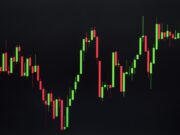Stocks closed lower after a week of whipsaw trading, despite Thursday’s historic rebound where the S&P 500 jumped 2.6% to break a six-day losing streak in its fifth most significant intraday reversal from a low in history.
This week brought the official beginning of the corporate earnings season, with major banks reporting mixed results. Expectations dwindled heading into the start of the season. According to FactSet 65 S&P companies have issued negative guidance, versus just 41 S&P companies providing positive outlooks.
With volatility widely expected to persist over the coming weeks, knowing which stocks are golden opportunities to take advantage of and which ones to avoid or sell is crucial. In this list, our team examines two stocks that could present a potential buying opportunity in the coming days and one stock to avoid until further notice.
The decline in tech may be offering investors what many would consider a once-in-a-lifetime opportunity in some notable names. Our first recommendation for this week is one such company with many positive attributes, including a deep economic moat, high operating margins, and a strong balance sheet to boot.
Google parent Alphabet (GOOG, GOOGL) recently dipped below $100 after its recent 20-for-1 stock split. At its lowest level in over a decade, the stock is more accessible for investors, which should help when enthusiasm for big tech stocks re-accelerates.
Over the last five years, GOOGL is up 101%, to crush the Nasdaq’s 64% gain and the Internet Services Market’s 72% gain over the same period. The company posted earnings per share of $1.21 on revenue that grew by 12.6% year-over-year to $69.69 billion. The consensus sees earnings dropping 7% in 2022 but rising in 2023 at $5.80 a share. Top-line growth is expected, with 2022 sales expected to climb 11% and another 10% in 2023 to $260.44 billion.
Key catalysts to watch out for include its artificial intelligence tools that help users search in new ways, such as Google Lens, which is currently being used over 8 billion times a month. Google also recently introduced a new multi-search feature to help users search with both words and images simultaneously. Shares also have a strong rebound potential once the digital ad market recovers.
At 19 times forward earnings, Alphabet shares are trading in line with the S&P 500. Still, the current earnings multiple may underestimate the company’s potential to re-accelerate earnings once its many growth catalysts start to play out.
Since the U.S. government officially introduced the first-ever tax credit for clean energy storage projects earlier this year, there have been remarkable positive business developments in the industry. Our following recommendation is a pure play on the smart energy storage space offering artificial intelligence-driven clean energy storage systems.
Stem Inc’s (STEM) advanced energy storage solutions with Athena(TM), an artificial intelligence-powered analytics platform, enables customers and partners to optimize energy use by automatically switching between battery power, onsite generation, and grid power.
The company has already built up considerable infrastructure with established names, and STEM’s Athena Software seems likely to become mission-critical for many electric utilities because of the rapidly increasing supply and demand for renewable energy.
For the second quarter, which ended June 30th, Stem reported a record-breaking backlog of $727 million, up 191% from $250 million at the end of Q2 2021. Bookings were up 402% from $45 million to $226 million, and the 12-month pipeline increased 8% from the previous quarter to $5.2 billion. Revenue grew a whopping 246% year-over-year and reached 5% above the high end of guidance at $67 million.
We are encouraged by Congressional support for the Inflation Reduction Act of 2022. The climate provisions in the Act would drive continued investment in America’s aging power grid, support customer adoption of renewable energy, and improve energy security by incentivizing development of our domestic supply chain. Importantly, a stand-alone Investment Tax Credit (ITC) for energy storage, and the extension of the solar ITC, would improve the economic returns for our customers.”
“Supply chain constraints, permitting and interconnection delays, and certain regulatory actions continue to pose challenges, but we believe we remain well-positioned to manage these risks and continue with our strong execution through the rest of 2022,” commented John Carrington, Chief Executive Officer of Stem.
STEM has high growth potential and looks like an ideal long-term investment. Athena looks like an industry-changing platform with wide-ranging applications. STEM’s infrastructure is far ahead of its competitors and will prove to be a crucial piece of the investment thesis moving forward.
While the future remains bright for renewable energy, not all solar stocks are a buy. Provider of solar engineering and construction services, iSun Inc. (ISUN), has seen operating losses skyrocket alongside revenue increases in recent years. Therefore the stock made it to the list as the stock to sell next week.
iSun reported a second-quarter 2022 revenue of $16.5 million, representing a $12.1 million or 278% increase over the same period in 2021. Alongside top-line growth over the past year, the company has reported $15.3 million in operating losses. Operating income in the second quarter was a loss of $5.6 million compared to a loss of $2.8 million over the same period in 2021. YTD’s operating income was a loss of $11.3 million compared to a loss of $5.4 million during the same period in 2021.
Given the company’s already high debt position after a series of acquisitions in 2021, the additional losses could force it to raise equity to de-lever its balance sheet, which could mean further declines for iSun.
The small, unprofitable solar company’s stock is down 72% over the past 12 months, but it’s far from a bargain considering the risk factor.
Read Next – Get Out of U.S. Banks Immediately
A Wall Street legend has warned 8.4 million Americans to prepare immediately.
“A historic financial reset in 2023 could cause a run on the banks unlike anything we’ve seen in our country’s history,” he says.
Marc Chaikin has already appeared on 30 different TV networks to share his warning.
Even CNBC’s Jim Cramer has taken notice.
But few people realize this could actually happen on U.S. soil.
Or what a sizable impact it could have on your wealth, especially if you have large amounts of cash in the bank right now.
Chaikin is best known for predicting the COVID-19 crash, the 2022 sell-off, and the overnight collapse of Priceline.com during a CNBC debate.
In his 50-year Wall Street career, he worked with hedge funds run by billionaires Paul Tudor Jones and George Soros.
But today, he is now urging you to move your money out of cash and popular stocks and into a new vehicle 50 years in the making.
“This is by far the best way to protect and grow your money in what will surely be a very difficult transition for most people,” Chaikin says.
Click here for the full story, and his free recommendation.





